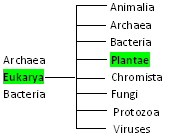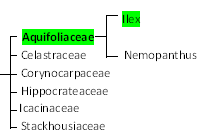Phylogeny

Ilex aquifolium is classified in domain Eukarya because of its Eukaryotic
cells. It is further classified into the kingdom Plantae along with thousands of
other multicellular organisms that contain chlorophyll and produce food through
photosynthesis.
Figure 1: Domain and
kingdom classification.
English Holly is part of the
phylum Magnoliophyta. This phylum is one

of the
largest and most diverse groups on
the planet with over 270,000 species. Plants
in this group occupy every habitat on Earth with the exception of a number of
extreme environments. Magnoliophytes come in all shapes and sizes and are vital
to human existence. There are five defining characteristics of the phylum
Magnoliophyta:
1) All have ovules that are enclosed in a carpel.
2) All experience double fertilization and the formation of
endospores.
3) All have stamens with two pollen sacs.
4) All have features of gametophyte structure and function.
5) All have phloem tissue composed
of sieve tubes and
companion cells. Figure 2: Kingdom
and phylum classification.

English Holly can be furthered classified into the class Magnoliopsida. The
170,000 species that belong to this class have woody stems and can be annuals,
biennials, vines, aquatic plants, parasites, or saprophytes. They tend to have
vascular bundles in a ring and most have a primary root system. Common
characteristics include two cotyledons and net-like veins in the leaves.
Figure 3: Phylum and class
classification.

Ilex aquifolium belongs to the Celastrales order. This order is composed of both
trees and shrubs and contains over 800 species. Many species in this group are
either climbing or vine plants that are native to tropical and temperate zones.
Most Celastrales have colorful fruit, leathery leaves, and small flowers with
four or five petals each.
Figure 4: Class and order
classification.

The family Aquifoliaceae contains English Holly and around 400 other species
split into two genera. Nearly all species belonging to Aquifoliaceae are
variations of hollies. Most species are evergreen trees and shrubs with small
white or pale green flowers.
Figure 5: Order and family classification.
 The genus Ilex contains over 95% of the species classified in the Aquifoliaceae
family. Ilex contains all of the different variations of Holly trees and shrubs.
Members of this genus are both evergreen and deciduous and typically have spiny
or serrated leaves. The Hollies are best known for their colorful fruits. The genus Ilex contains over 95% of the species classified in the Aquifoliaceae
family. Ilex contains all of the different variations of Holly trees and shrubs.
Members of this genus are both evergreen and deciduous and typically have spiny
or serrated leaves. The Hollies are best known for their colorful fruits.
Figure 6: Family and genus classification.

And finally the species Ilex aquifolium,
which you can learn all about through the many pages on this website!
Figure 7: Genus and species
classification.
Adaptations anyone?...
|